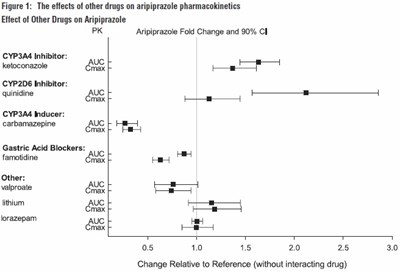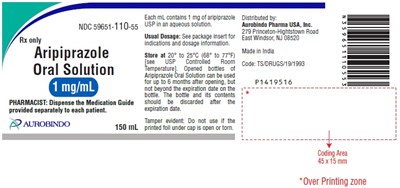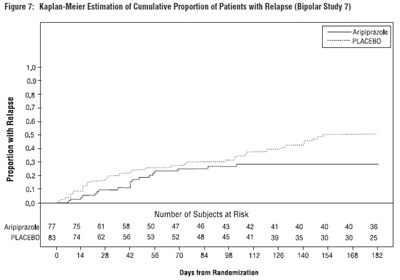Product Images Aripiprazole
View Photos of Packaging, Labels & Appearance
- Figure 1: The effects of other drugs on aripiprazole pharmacokinetics - aripiprazole fig1
- PACKAGE LABEL-PRINCIPAL DISPLAY PANEL - 1 mg/mL (150 mL Carton Label) - aripiprazole fig10
- aripiprazole fig11
- Figure 2: The effects of other drugs on dehydro-aripiprazole pharmacokinetics - aripiprazole fig2
- Figure 3: The effects of aripiprazole on pharmacokinetics of other drugs - aripiprazole fig3
- Figure 4: Effects of intrinsic factors on aripiprazole pharmacokinetics - aripiprazole fig4
- Figure 5: Effects of intrinsic factors on dehydro-aripiprazole pharmacokinetics - aripiprazole fig5
- Figure 6: Kaplan-Meier Estimation of Cumulative Proportion of Patients with Relapse (Schizophrenia Study 5) - aripiprazole fig6
- Figure 7: Kaplan-Meier Estimation of Cumulative Proportion of Patients with Relapse (Bipolar Study 7) - aripiprazole fig7
- Figure 8: Kaplan-Meier Estimation of Cumulative Proportion of Patients with Relapse to Any Mood Event (Bipolar Study 8) - aripiprazole fig8
- PACKAGE LABEL-PRINCIPAL DISPLAY PANEL 1 mg/mL (150 mL Bottle) - aripiprazole fig9
- Chemical Structure - aripiprazole str
Product Label Images
The following 12 images provide visual information about the product associated with Aripiprazole NDC 59651-110 by Aurobindo Pharma Limited, such as packaging, labeling, and the appearance of the drug itself. This resource could be helpful for medical professionals, pharmacists, and patients seeking to verify medication information and ensure they have the correct product.
Figure 1: The effects of other drugs on aripiprazole pharmacokinetics - aripiprazole fig1

The diagram displays the effects of various drugs on the metabolism of Aripiprazole, a medication used to treat certain mental conditions. The drugs are divided into categories, such as CYP3A4 inhibitors and inducers, CYP2D6 inhibitors, Gastric Acid Blockers, and others. The fold change and 90% confidence interval of the Aripiprazole pharmacokinetics are indicated on the Y-axis, and the relative change in comparison to a reference point (without interacting drug) is on the X-axis. The drugs listed in the diagram include Keloconazoe, quinidine, carbamazepine, famolidine, valroste, lithium, and lorazepam.*
PACKAGE LABEL-PRINCIPAL DISPLAY PANEL - 1 mg/mL (150 mL Carton Label) - aripiprazole fig10

This is a description of Aripiprazole Oral Solution, a prescription medication containing 1mg of aripiprazole in each milliliter of aqueous solution. The package insert contains dosage and indication information. The solution should be stored at a controlled room temperature between 20 and 25 degrees Celsius and should not be used beyond the expiration date indicated on the bottle. The botttle should be discarded after 6 months of opening. Patients are advised not to use if the printed seal under the cap is open or damaged. The medicine is distributed by Aurobindo Pharma USA, Inc. from a facility in East Windsor, NJ.*
aripiprazole fig11

This is a description of Aripiprazole oral solution. It contains 1mg of aripiprazole, USP in an aqueous solution. The usual dosage and storage temperatures are provided in the description along with instructions to discard the bottle after the expiration date. The medication guide must be dispensed separately to each patient. The product is distributed by Aurobindo Pharma USA, Inc. and made in India. NDC code 59651-110-55 is mentioned in the description.*
Figure 2: The effects of other drugs on dehydro-aripiprazole pharmacokinetics - aripiprazole fig2

The figure shows the impact of other drugs on dehydro-aripiprazole pharmacokinetics. The drugs include CYP3A4 inhibitor, CYP2D6 inhibitor, CYP3Ad inducer, gastric acid blockers, and others. There is a fold change in Dehydro-Aripiprazole and 90% Confidence Interval (CI) for each drug, which varies from -1 to 27. The changes relative to reference (without interacting drug) range from 5 to 30.*
Figure 3: The effects of aripiprazole on pharmacokinetics of other drugs - aripiprazole fig3

This is a figure presenting the effects of aripiprazole on the pharmacokinetics of several drugs, including warfarin, rovarfarin, omeprazole, lamatigine, valproate, tium, lorazepam, venlafaxine, O-desmethyheniaaine, and escitalopram. The fold change and 80% confidence interval of each drug's effect are shown on a graph. No additional information or context is available.*
Figure 4: Effects of intrinsic factors on aripiprazole pharmacokinetics - aripiprazole fig4

This is a table showing the effects of various intrinsic factors on pharmacokinetics of aripiprazole. The factors include CYP206, gender, and age among others. The effects are presented as AUC and Cmax. There is a comparison of poor vs. extensive metabolizers and severe vs. normal renal impairment. The fold change and 90% CI are also included.*
Figure 5: Effects of intrinsic factors on dehydro-aripiprazole pharmacokinetics - aripiprazole fig5

The text provides a figure showing the effects of various intrinsic factors on the pharmacokinetics of dehydro-aripiprazole. These factors include metabolizer type, gender, age, hepatic and renal impairment. The graph shows fold change and 90% confidence intervals for dehydro-aripiprazole in relation to a reference. However, the values seem incomplete and not easily understandable due to errors.*
Figure 6: Kaplan-Meier Estimation of Cumulative Proportion of Patients with Relapse (Schizophrenia Study 5) - aripiprazole fig6

The text describes a Kaplan-Meier Estimation graph that shows the cumulative proportion of patients with relapse in a schizophrenia study. There are two groups represented on the graph: Aripiprazole and Placebo. The X-axis shows the number of days from randomization, and the Y-axis displays the proportion of patients with the relapse. The graph also includes a table that shows the number of subjects at risk for both groups at different time intervals.*
Figure 7: Kaplan-Meier Estimation of Cumulative Proportion of Patients with Relapse (Bipolar Study 7) - aripiprazole fig7

The text shows a figure 7 that displays the Kaplan-Meier Estimation of Cumulative Proportion of Patients with Relapse for Bipolar Study 7. The graph compares the proportion with relapse against the number of subjects at risk for Arpiprazole and Placebo groups. The x-axis represents days from Randomization, and the y-axis represents the proportion with relapse. The Arpiprazole group had 77 subjects at the start, and the Placebo group had 83 subjects. The text also displays the number of subjects at risk for the two groups at different time intervals.*
Figure 8: Kaplan-Meier Estimation of Cumulative Proportion of Patients with Relapse to Any Mood Event (Bipolar Study 8) - aripiprazole fig8

This is a graph showing the Kaplan-Meier estimation of the cumulative proportion of patients with relapse to any mood event in a study (Study 8) for a drug called Aripiprazole compared to PLACESO. The x-axis shows the number of days from randomization and the y-axis shows the proportion with relapse. The graph also shows the number of subjects at risk at different time points.*
PACKAGE LABEL-PRINCIPAL DISPLAY PANEL 1 mg/mL (150 mL Bottle) - aripiprazole fig9

This text appears to be describing a graph or chart that shows the change in a YGTSS Total TIC Score over a period of treatment, with two different doses of Aripiprazole medication compared to a placebo. The graph shows the mean change in score over time, with the Aripirazole High dose decreasing the score the most and the placebo having the smallest effect. The graph covers a 4-week treatment period.*
* The product label images have been analyzed using a combination of traditional computing and machine learning techniques. It should be noted that the descriptions provided may not be entirely accurate as they are experimental in nature. Use the information in this page at your own discretion and risk.
